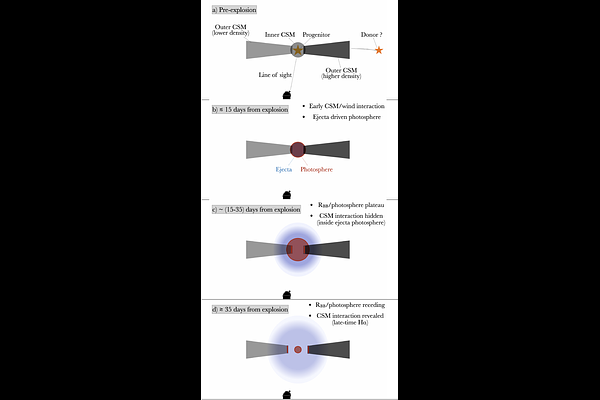Luminous, rapidly declining supernovae as stripped transitional objects in low metallicity environments: the case of SN 2022lxg

Luminous, rapidly declining supernovae as stripped transitional objects in low metallicity environments: the case of SN 2022lxg
P. Charalampopoulos, R. Kotak, J. Sollerman, C. P. Gutiérrez, M. Pursiainen, T. L. Killestein, S. Schulze, P. J. Pessi, K. Maeda, T. Kangas, Y. -Z. Cai, C. Fremling, K. R. Hinds, T. Jegou du Laz, E. Kankare, M. M. Kasliwal, H. Kuncarayakti, P. Lundqvist, F. J. Masci, S. Mattila, D. A. Perley, A. Reguitti, T. M. Reynolds, M. Stritzinger, L. Tartaglia, J. Van Roestel, A. Wold
AbstractWe present an analysis of the optical and near-infrared properties of SN 2022lxg, a bright ($\rm M_{g\, \mathrm{peak}}=-19.41$ mag) and rapidly evolving SN. It was discovered within a day of explosion, and rose to peak brightness in 10 d. Two distinct phases of circumstellar interaction are evident in the data. The first is marked by a steep blue continuum (T $>15,000$ K) with flash-ionisation features due to hydrogen and He II. The second, weaker phase is marked by a change in the colour evolution accompanied by changes in the shapes and velocities of the spectral line profiles. Narrow P-Cygni profiles (~ $150$ km s$^{-1}$) of He I further indicate the presence of slow-moving unshocked material and suggesting partial stripping of the progenitor. The fast decline of the light curve from peak (3.48$\pm$ 0.26 mag $\rm (50\,d)^{-1}$ in $g$-band) implies that the ejecta mass must be low. Spectroscopically, until $+35$ d there are similarities to some Type IIb SNe but then there is a transition to spectra that are more reminiscent of an interacting SN II. However, metal lines are largely absent in the spectra, even at epochs of 80 d. Its remote location from the presumed host galaxy, a dwarf with $\rm M_B$ ~ $-14.4$ mag, is consistent with our metallicity estimate - close to the SMC value - obtained from scaling relations. Furthermore, several lines of evidence (including intrinsic polarisation of $p$ ~ (0.5-1.0) %) point to deviations from spherical symmetry. We suggest that a plausible way of uniting the observational clues is to consider a binary system that underwent case C mass transfer. This failed to remove the entire H-envelope of the progenitor before it underwent core-collapse. In this scenario, the progenitor itself would be more compact and perhaps straddle the boundary between blue and yellow supergiants, tying in with the early spectroscopic similarity to Type IIb SNe.